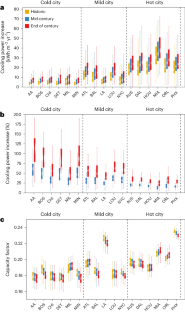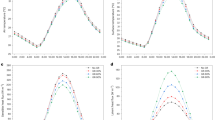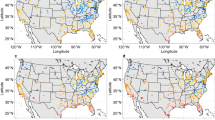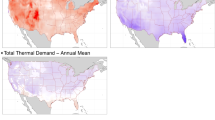Abstract
Rooftop solar adoption is critical for residential decarbonization and hinges on its value to households. Climate change will probably affect the value of rooftop solar through impacts on rooftop solar generation and cooling demand, but no studies have quantified this effect. In this study, we quantified household-level effects of climate change on rooftop solar value and techno-economically optimal capacity by integrating empirical demand data for over 2,000 US households across 17 cities, household-level simulation and optimization models, and downscaled weather data for historic and future climates. We found that climate change will increase the value of rooftop solar to households by up to 19% and increase techno-economically optimal household capacity by up to 25% by the end of the century under a Representative Concentration Pathway 4.5 scenario. This increased value is robust across cities, households, future warming scenarios and retail tariff structures. Researchers, installers and policymakers should capture this increasing value to maximize household and system value of rooftop solar.
This is a preview of subscription content, access via your institution
Access options
Access Nature and 54 other Nature Portfolio journals
Get Nature+, our best-value online-access subscription
$29.99 / 30 days
cancel any time
Subscribe to this journal
Receive 12 print issues and online access
$209.00 per year
only $17.42 per issue
Buy this article
- Purchase on Springer Link
- Instant access to full article PDF
Prices may be subject to local taxes which are calculated during checkout





Similar content being viewed by others
Data availability
The individual hourly cooling behaviour data can be obtained from Ecobee upon request38. The future TGW climate data are from the US Department of Energy Office of Scientific and Technical Information39 and are publicly available. Other data sources are provided in Methods and Supplementary Information. The household-level VOS and optimal solar capacity data are available via Figshare at https://doi.org/10.6084/m9.figshare.25296250.v1 (ref. 64).
Code availability
The codes (python scripts) are available via Figshare at https://doi.org/10.6084/m9.figshare.25296250.v1 (ref. 64), including model codes (HHAC model, solar potential mapping and VOS optimization) and figure production codes (Figs. 1–5).
References
IPCC Special Report on Global Warming of 1.5 °C (eds Masson-Delmotte, V. et. al.) (WMO, 2018).
IPCC Climate Change 2022: Impacts, Adaptation and Vulnerability (eds Pörtner, H.-O. et al.) (Cambridge Univ. Press, 2022).
Bouckaert, S., McGlade, C., Remme, U. & Wanner, B. Net Zero by 2050: A Roadmap for the Global Energy Sector (IEA, 2021).
Larson, E. et. al. Net-Zero America: Potential Pathways, Infrastructure, and Impacts (Princeton Univ., 2021).
Zhang, S. & Chen, W. Assessing the energy transition in China towards carbon neutrality with a probabilistic framework. Nat. Commun. 13, 87 (2022).
Jones-Albertus, B. et. al. Solar Futures Study (Office of Energy Efficiency and Renewable Energy, US Department of Energy, 2021).
Schulte, E., Scheller, F., Sloot, D. & Bruckner, T. A meta-analysis of residential PV adoption: the important role of perceived benefits, intentions and antecedents in solar energy acceptance. Energy Res. Soc. Sci. 84, 102339 (2022).
Alipour, M., Salim, H., Stewart, R. A. & Sahin, O. Residential solar photovoltaic adoption behaviour: end-to-end review of theories, methods and approaches. Renew. Energy 170, 471–486 (2021).
Ashraf Fauzi, M., Hanis Zainal Abidin, N., Mohd Suki, N. & Mokhtar Albshir Budiea, A. Residential rooftop solar panel adoption behavior: bibliometric analysis of the past and future trends. Renew. Energy Focus 45, 1–9 (2023).
Shimada, H. & Honda, T. What drives households’ choices of residential solar photovoltaic capacity? Energy Policy 168, 113120 (2022).
Jacksohn, A., Grösche, P., Rehdanz, K. & Schröder, C. Drivers of renewable technology adoption in the household sector. Energy Econ. 81, 216–226 (2019).
Hansen, L. et. al. A Review of Solar PV Benefit and Cost studies (Rocky Mountain Institute, 2013).
Sexton, S., Kirkpatrick, A. J., Harris, R. I. & Muller, N. Z. Heterogeneous solar capacity benefits, appropriability, and the costs of suboptimal siting. J. Assoc. Environ. Resour. Econ. 8, 1209–1244 (2021).
Meriläinen, A., Puranen, P., Kosonen, A. & Ahola, J. Optimization of rooftop photovoltaic installations to maximize revenue in Finland based on customer class load profiles and simulated generation. Sol. Energy 240, 422–434 (2022).
Beuse, M., Dirksmeier, M., Steffen, B. & Schmidt, T. S. Profitability of commercial and industrial photovoltaics and battery projects in South-East Asia. Appl. Energy 271, 115218 (2020).
Shi, M. et al. Opportunity of rooftop solar photovoltaic as a cost-effective and environment-friendly power source in megacities. iScience 25, 104890 (2022).
Tongsopit, S. et al. The economics of solar PV self-consumption in Thailand. Renew. Energy 138, 395–408 (2019).
Taylor, M. et al. Value of Solar: Program Design and Implementation Considerations (National Renewable Energy Laboratory, 2015).
Ossenbrink, J. How feed-in remuneration design shapes residential PV prosumer paradigms. Energy Policy 108, 239–255 (2017).
O’Shaughnessy, E., Barbose, G., Wiser, R., Forrester, S. & Darghouth, N. The impact of policies and business models on income equity in rooftop solar adoption. Nat. Energy 6, 84–91 (2021).
Lu, X. et al. Combined solar power and storage as cost-competitive and grid-compatible supply for China’s future carbon-neutral electricity system. Proc. Natl Acad. Sci. USA 118, e2103471118 (2021).
Adeyemi-Kayode, T. M., Misra, S., Maskeliunas, R. & Damasevicius, R. A bibliometric review of grid parity, energy transition and electricity cost research for sustainable development. Heliyon 9, e15532 (2023).
Lang, T., Ammann, D. & Girod, B. Profitability in absence of subsidies: a techno-economic analysis of rooftop photovoltaic self-consumption in residential and commercial buildings. Renew. Energy 87, 77–87 (2016).
Waibel, C., Hsieh, S. & Schlueter, A. Impact of demand response on BIPV and district multi-energy systems design in Singapore and Switzerland. In Carbon Neutral Cities—Energy Efficiency and Renewables in the Digital Era (CISBAT 2021) Vol. 2042 (The Electrochemical Society, 2021).
Ramasamy, V. et al. U.S. Solar Photovoltaic System and Energy Storage Cost Benchmarks, With Minimum Sustainable Price Analysis: Q1 2022 (National Renewable Energy Laboratory, 2022).
Feron, S., Cordero, R. R., Damiani, A. & Jackson, R. B. Climate change extremes and photovoltaic power output. Nat. Sustain. 4, 270–276 (2021).
Crook, J. A., Jones, L. A., Forster, P. M. & Crook, R. Climate change impacts on future photovoltaic and concentrated solar power energy output. Energy Environ. Sci. 4, 3101–3109 (2011).
Jerez, S. et al. The impact of climate change on photovoltaic power generation in Europe. Nat. Commun. 6, 10014 (2015).
Wild, M., Folini, D., Henschel, F., Fischer, N. & Müller, B. Projections of long-term changes in solar radiation based on CMIP5 climate models and their influence on energy yields of photovoltaic systems. Sol. Energy 116, 12–24 (2015).
Gernaat, D. E. H. J. et al. Climate change impacts on renewable energy supply. Nat. Clim. Change 11, 119–125 (2021).
Deroubaix, A. et al. Large uncertainties in trends of energy demand for heating and cooling under climate change. Nat. Commun. 12, 5197 (2021).
Ortiz, L., González, J. E. & Lin, W. Climate change impacts on peak building cooling energy demand in a coastal megacity. Environ. Res. Lett. 13, 094008 (2018).
Laine, H. S. et al. Meeting global cooling demand with photovoltaics during the 21st century. Energy Environ. Sci. 12, 2706–2716 (2019).
Isaac, M. & van Vuuren, D. P. Modeling global residential sector energy demand for heating and air conditioning in the context of climate change. Energy Policy 37, 507–521 (2009).
Kan, X., Hedenus, F., Reichenberg, L. & Hohmeyer, O. Into a cooler future with electricity generated from solar photovoltaic. iScience 25, 104208 (2022).
Wang, H. et al. Optimization of clustering analysis of residential electricity consumption behavior. In Proc. 14th IEEE Conference on Industrial Electronics and Applications (ICIEA) 418–423 (IEEE, 2019).
Zhu, K., Victoria, M., Andresen, G. B. & Greiner, M. Impact of climatic, technical and economic uncertainties on the optimal design of a coupled fossil-free electricity, heating and cooling system in Europe. Appl. Energy 262, 114500 (2020).
Donate Your Data Researcher Handbook (Ecobee, 2019).
Jones, A. D. et al. IM3/HyperFACETS Thermodynamic Global Warming (TGW) Simulation Datasets (v1.0.0) (US Department of Energy Office of Scientific and Technical Information, 2022).
Dessler, A. E. A determination of the cloud feedback from climate variations over the past decade. Science 330, 1523–1527 (2010).
Power Sector Carbon Index (Scott Institute for Energy Innovation, Carnegie Mellon University, 2017); https://www.emissionsindex.org
Narvaez, G., Bressan, M., Pantoja, A. & Giraldo, L. F. Climate change impact on photovoltaic power potential in South America. Environ. Res. Commun. 5, 081004 (2023).
Zhang, J., You, Q. & Ullah, S. Changes in photovoltaic potential over China in a warmer future. Environ. Res. Lett. 17, 114032 (2022).
Lei, Y. et al. Co-benefits of carbon neutrality in enhancing and stabilizing solar and wind energy. Nat. Clim. Change https://doi.org/10.1038/s41558-023-01692-7 (2023).
Naderi, S., Pignatta, G., Heslop, S., MacGill, I. & Chen, D. Demand response via pre-cooling and solar pre-cooling: a review. Energy Build. 272, 112340 (2022).
Hunter, C. A. et al. Techno-economic analysis of long-duration energy storage and flexible power generation technologies to support high-variable renewable energy grids. Joule 5, 2077–2101 (2021).
Craig, M. T. et al. A review of the potential impacts of climate change on bulk power system planning and operations in the United States. Renew. Sustain. Energy Rev. 98, 255–267 (2018).
Hayhoe, K. et al. in Fourth National Climate Assessment. Volume II: Impacts, Risks, and Adaptation in the United States 72–144 (U.S. Global Change Research Program, 2018).
Craig, M. T. et al. Overcoming the disconnect between energy system and climate modeling. Joule 6, 1405–1417 (2022).
Local Climatological Data (LCD) (National Oceanic and Atmospheric Administration, 2023); https://www.ncei.noaa.gov/data/local-climatological-data/access/
Reyna, J. et al. U.S. Building Stock Characterization Study: A National Typology for Decarbonizing U.S. Buildings (National Renewable Energy Laboratory, 2022).
Literature library. Goodman Air Conditioning and Heating https://www.goodmanmfg.com/support/literature-library (2023).
Wildstein, P. J., Craig, M. T. & Vaishnav, P. Participant overrides can halve the reliability value of direct load control programs. Energy Build. 299, 113606 (2023).
Gagnon, P., Margolis, R., Melius, J., Phillips, C. & Elmore, R. Rooftop Solar Photovoltaic Technical Potential in the United States: A Detailed Assessment 70 (National Renewable Energy Laboratory, 2016).
Holmgren, W., Hansen, C. & Mikofski, M. pvlib python: a python package for modeling solar energy systems. J. Open Source Softw. 3, 884 (2018).
Erbs, D. G., Klein, S. A. & Duffie, J. A. Estimation of the diffuse radiation fraction for hourly, daily and monthly-average global radiation. Sol. Energy 28, 293–302 (1982).
2021 Annual Technology Baseline (NREL, 2021); https://atb.nrel.gov/
Burleyson, C., Thurber, T. & Vernon, C. Projections of Hourly Meteorology by County Based on the IM3/HyperFACETS Thermodynamic Global Warming (TGW) Simulations (v1.0.0) (MSD-LIVE Data Repository, 2023); https://doi.org/10.57931/1960548
Jones, A. D. et al. Continental United States climate projections based on thermodynamic modification of historical weather. Sci. Data 10, 664 (2023).
Kumar P. Bias-correction 0.4 (Python, 2022); https://pypi.org/project/bias-correction/
Sengupta, M. et al. The National Solar Radiation Data Base (NSRDB). Renew. Sustain. Energy Rev. 89, 51–60 (2018).
Gillett, M. P., Betkoski, J. W. III & Caron, M. A. Annual Residential Renewable Energy Tariff Program Review and Rate Setting (Public Utilities Regulatory Authority, State of Connecticut, 2021).
Time-of-use (TOU) rate plans. South California Edison https://www.sce.com/residential/rates/Time-Of-Use-Residential-Rate-Plans (2023).
Shi, M. S. et. al. Climate change will impact the value and optimal adoption of residential rooftop solar. Figshare https://doi.org/10.6084/m9.figshare.25296250.v1 (2024).
Acknowledgements
This work was supported by the National Natural Science Foundation of China (grant nos. 72025401, 72243007 and 72140003), the National Key Research and Development Program of China (Grant Nos. 2022YFC3702902, 2022YFC3702900 and 2023YFE0204600), the Carbon Neutrality and Energy System Transformation (CNEST) Project and the Ordos-Tsinghua Innovative & Collaborative Research Program in Carbon Neutrality. M.T.C. thanks the U.S. National Science Foundation under grant no. 2142421 for funding. We thank P. Wildstein for building modelling and grid tariff analysis and R. Jain for building simulations.
Author information
Authors and Affiliations
Contributions
M.S. developed the research concept, designed and performed the analysis, collected data, wrote the code and drafted the paper. M.T.C contributed to the development of the concept, reviewed the codes and revised the narrative structure and language of the paper. X.L. contributed to the draft paper and its revision.
Corresponding authors
Ethics declarations
Competing interests
The authors declare no competing interests.
Peer review
Peer review information
Nature Climate Change thanks Amarasinghage T. D. Perera, Zhili Wang and the other, anonymous, reviewer(s) for their contribution to the peer review of this work.
Additional information
Publisher’s note Springer Nature remains neutral with regard to jurisdictional claims in published maps and institutional affiliations.
Supplementary information
Supplementary Information
Supplementary Methods 1–7, Results 1–8, Figs. 1–43 and Tables 1–4.
Rights and permissions
Springer Nature or its licensor (e.g. a society or other partner) holds exclusive rights to this article under a publishing agreement with the author(s) or other rightsholder(s); author self-archiving of the accepted manuscript version of this article is solely governed by the terms of such publishing agreement and applicable law.
About this article
Cite this article
Shi, M., Lu, X. & Craig, M.T. Climate change will impact the value and optimal adoption of residential rooftop solar. Nat. Clim. Chang. (2024). https://doi.org/10.1038/s41558-024-01978-4
Received:
Accepted:
Published:
DOI: https://doi.org/10.1038/s41558-024-01978-4



